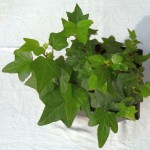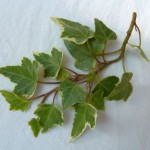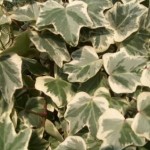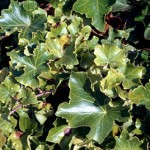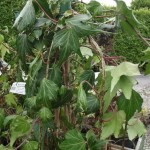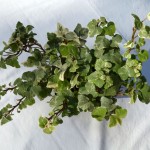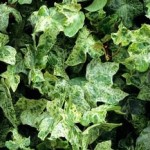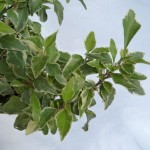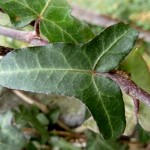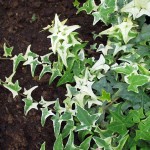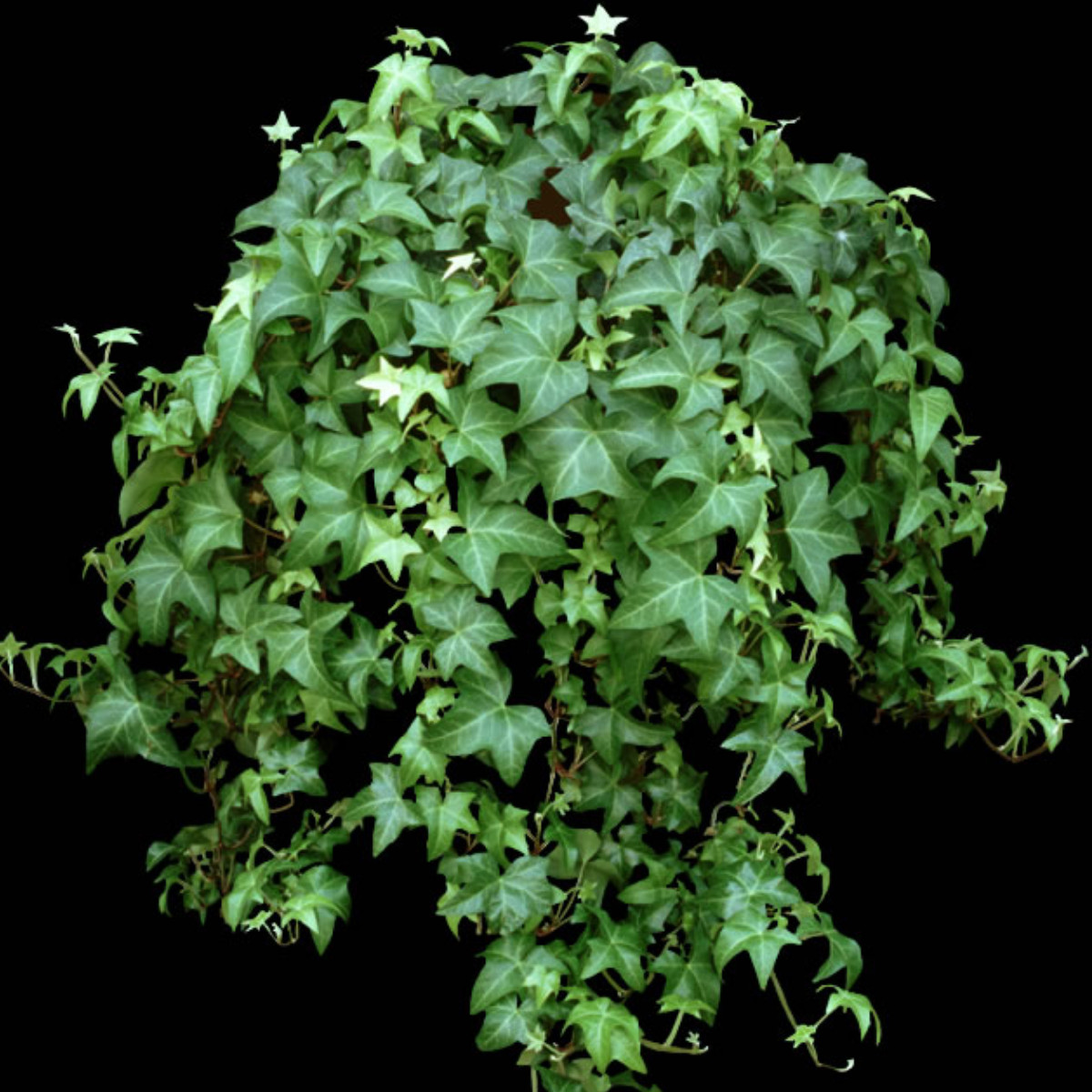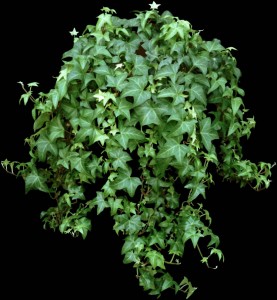Family: Araliaceae
Synonym: Hedera acuta
Hedera arborea
Hedera baccifera
Hedera grandifolia
Hedera poetica Salisb.
Hedera poetarum Bertol.
Distribution and habitat: Hedera helix is a species of ivy native to most of Europe and western Asia. It is labeled as an invasive species in a number of areas where it has been introduced.
It is an evergreen climbing plant, growing high where suitable surfaces (trees, cliffs, walls) are available, and also growing as ground cover where there are no vertical surfaces. It climbs by means of aerial rootlets with matted pads which cling strongly to the substrate.
The leaves are alternate and have petiole; they are of two types, with palmately five-lobed juvenile leaves on creeping and climbing stems, and unlobed cordate adult leaves on fertile flowering stems exposed to full sun, usually high in the crowns of trees or the top of rock faces. The flowers are produced from late summer until late autumn, individually small, in umbels, greenish-yellow, and very rich in nectar, an important late autumn food source for bees and other insects.
The fruit are purple-black to orange-yellow berries, ripening in late winter and are an important food for many birds, though somewhat poisonous to humans.
Description: Hedera helix has typically ivy-shaped leaves with tree to five lobes of which the one at the apex is the longest and most pointed. The original species has been superseded by its many varieties. Most of the following plants are self branching (each stem tend to branch naturally at frequent intervals) and this makes the plants dense and rather bushy.
Houseplant care: Winter growth of English Ivy plants tends to be very long without bearing many leaves. Trim areas like this with lots of woody growth but few leaves. For the plant to fill out properly during growth cut the stems down to strong growth areas.
Light: Native to light woodland areas,Hedera helix as houseplant thrive in an environment of bright filtered to low light. Ample light helps the leaves become more colorful but filter the light to prevent excessive heat which can lead to drying and poor performance.
Temperature: Hedera helix plants are not greatly affected by hot and cold temperature, but fluctuating temperatures can stifle performance dramatically. KeepHedera helix in an atmosphere with a consistent temperature and away from drafts, open doors, or vents. In temperatures above 18oC (64oF) provide extra humidity.
During the winter months encourage them to take a short rest by keeping them cool. A temperature of 10oC(50oF) is ideal.
Water: Hedera helix plants prefer an evenly moist environment. Water the plants freely during growth. KeepHedera helix houseplants moist in the winter. SprayingHedera helix with soft water weekly will help prevent spider mites from infesting the plants.
Fertilising: Hedera helix care requires the monthly application of liquid fertilizer or, another option often preferred, is to apply a quarter strength fertilizer when watering.
Potting and repoting: Use a soil based potting mixture. Overcrowded plants can be repotted during any season. Move the plant in a pot one size larger whatever pale roots emerge through drainage holes. Maximum pot size should be 12-15cm (5-6 inch). Top dress annually those plants that are not being moved on. For best effect put four or six small plants in a single basket.
Propagation: Root cuttings are the preferred method of propagation. Root the 10-15cm (4-6 inch) cuttings of young (not matured) growth during the spring to autumn. More mature cuttings (adult growth) of 18-23cm (7-9 inches) will produce a bushy tree-ivy type of growth but root very slowly if at all.
Problems: Plant care and maintenance helps reduce these problems.
Common pests affectingHedera helix are spider mites, aphids, mealybugs and scale insects. Red spider mites are often difficult to see without a close inspection. However, white webs formed on the plant are usually indicative of a spider mite infestation.
Treatment: Remove the infested leaves and treat the plant with a pesticide or insecticidal soap.
Typical pathogen (fungal and bacterial) problems affecting English Ivy houseplants are bacterial spot, stem rot and fungal leaf spots.
Treatment: Apply fungicides and repeat the treatment as mentioned on fungicide instructions.
Recommended varieties:There are several different species of theHedera helix that have different leaf shape, size and color.
Hedera helix 'Chicago' has 2-3 cm (0.7-1.2 inch) long and 3cm (1.2 inch) wide, medium greenleaves. The lives of one of its forms, Hedera helix 'Chicago Variegata' are creamy-edged. Those of another Hedera helix 'Golden Chicago' are marked with golden yellow patches.
Hedera helix 'Cristata' (Parsley Ivy) has 3-4cm (1.2-1.5 inch) long and 4cm (1.5 inch) wide medium green leaves that are so notably undulate as to seem curly-edged.
Hedera helix 'Emerald Gem' and Hedera helix 'Emerald Jewel' both have 2cm (0.7 inch) long and 3cm (1.2 inch) wide, sharply pointed, emerald green leaves.
Hedera helix 'Glacier' has 3cm (1.2 inch) long and 2cm (0.7 inch) wide leaves which are medium green with grey-green blotches, white marginal patches and pink edges. For dense growth this plant needs pinching out two or three times a year.
Hedera helix 'Jubilee' has 2cm long and 1.5-2cm (0.5-0.7 inch) wide dark green leaves variegated with grey and white. This variety is notably dense.
Hedera helix 'Little Diamond' has roughly diamond shaped, 2cm (0.7 inch) long and 1.5cm (0.5 inch) wide, medium green leaves thinly bordered with white. It needs pinching out to become bushy.
Hedera helix 'Lutzii' has 3cm (1.2 inch) long and 2 cm (0.7 inch) wide, dark green leaves covered with pale green and yellow spots. Not self-branching it needs pinching out two or three times a year.
Hedera helix 'Sagittifolia' has arrow-head-shaped, 4cm (1.5 inch) long and 3cm (1.2 inch) wide, dark green leaves. A variegated form, Hedera helix 'Sagittifolia Variegata' has light green and pale yellow markings. These plants make an excellent trailers, but growing points must be pinched out if bushy growth is desired.
Uses: Hedera helix is a popular ornamental, valued for its ability to thrive in shady places, provide excellent groundcover and cover unsightly walls, sheds and tree stumps. The evergreen, woody-stemmed plants are often seen trailing across yards and gardens, climbing walls, or encouraged as climbers along a supporting pole inside homes for a beautiful and decorative houseplant accent.Very easy to grow, ivy makes a very attractive hanging plant. Although the specimen above looks leggy, ivy can be very bushy if planted in mass.
Hedera helix is frequently used in cut flower arrangements, particularly in winter displays. The glossy, cream, ivory-like heartwood is sometimes used in flower arrangements.
Hedera helix is an ideal houseplant for people who have pets. Scientifically termed as Hedera Helix, this plant is known to filter indoor pollutants like fecal particles, formaldehyde aerosols and much more and keep the house toxin free.
It's known for removing the chemical benzene, a known carcinogen found in cigarette smoke, detergents, pesticides, and the off-gasing of other synthetic materials, is said to be fantastic for asthma and allergies and also removes formaldehyde. Hedera helixis particularly effective against benzene found in oil-based paints, detergents and plastic material.
SUMMARY
CHARACTERISTICS:
Foliage green / variegated
Shape climbing & trailing
PROPER CARE:
Watering in rest period sparingly
Watering in active growth period moderately
Light bright
Temperature in active growth period min 16oC max 24oC (60-75oF)
Humidity high
Hardiness zone: 5a-9b
